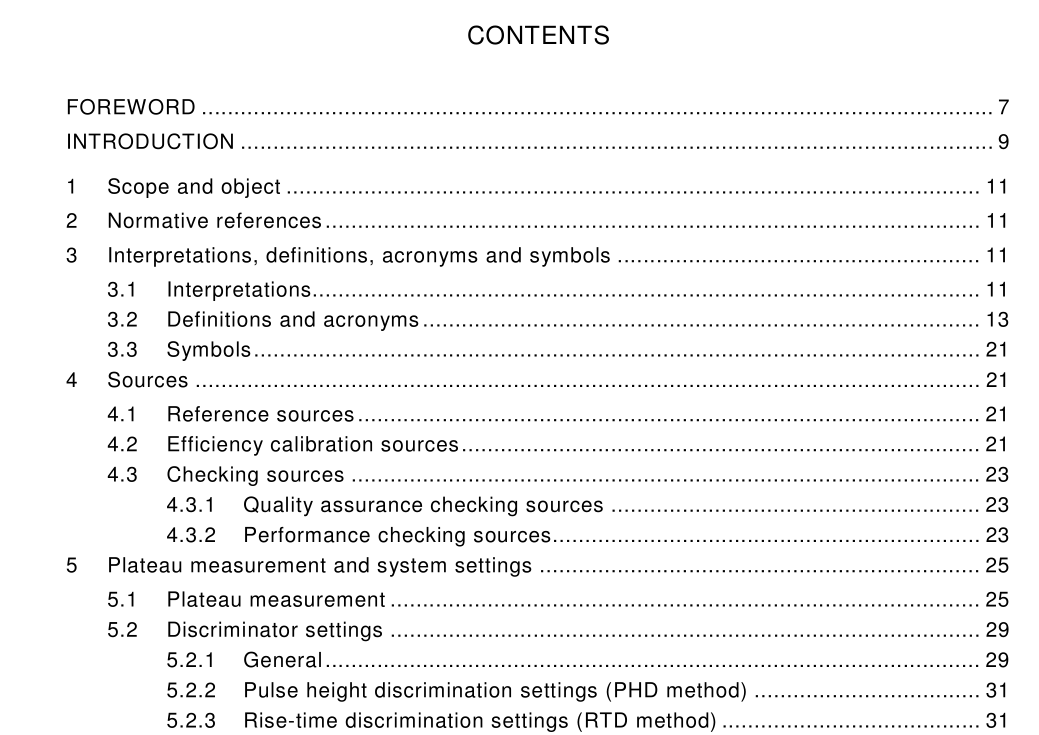IEC 62089 pdf download

IEC 62089 pdf download.Nuclear instrumentation – Calibration and usage of alpha/beta gas proportional counters
1 Scope and object
This International Standard applies to alpha/beta gas proportional counting systems used for the determination of the alpha-ray or beta-ray emission rates of radionuclides in sample counting. The intent is to establish standard methods for calibration and use of alpha/beta gas proportional counters, including measurement of their characteristics. Though principally applicable to beta-ray energies in excess of 100 keV, the techniques described in this standard are also useful for beta-ray energies at lower energies, provided a higher degree of care is taken with regard to sample preparation and calibration and measurement details.
2 Normative references
The following normative documents contain provisions which, through reference in this text, constitute provisions of this International Standard. For dated references, subsequent amendments to, or revisions of, any of these publications do not apply. However, parties to agreements based on this International Standard are encouraged to investigate the possibility of applying the most recent editions of the normative documents indicated below. For undated references, the latest edition of the normative document referred to applies. Members of IEC and ISO maintain registers of currently valid International Standards. IEC 60050(393):1996, International Electrotechnical Vocabulary (IEV) – Chapter 393: Nuclear instrumentation: Physical phenomena and basic concepts IEC 60050(394):1995, International Electrotechnical Vocabulary (IEV) – Chapter 394: Nuclear instrumentation: Instruments ISO 8769:1988, Reference sources for the calibration of surface contamination monitors – Beta-emitters (maximum beta energy greater than 0,15 MeV) and alpha-emitters ISO 8769-2:1996, Reference sources for the calibration of surface contamination monitors – Part 2: Electrons of energy less than 0,15 MeV and photons of energy less than 1,5 MeV ISO:1995, Guide to the expression of uncertainty in measurement VIM, International vocabulary for metrology
3 Interpretations , definitions, acronyms and s ymbols
3.1 Interpretations In this standard, the word “shall” denotes a requirement and the word “should” denotes a recommendation. The word “may” is used for stating permission but is also used in a more general sense. To conform to this standard, alpha/beta gas proportional counting shall be in accordance with its requirements but not necessarily in accordance with the recommend- ations; however, justification should be documented for deviations from a recommendation.3.2 Definitions and acronyms For the purpose of this International Standard, the following definitions, abbreviations and acronyms apply. 3.2.1 activity (symbol: A) quotient of dN by dt, where dN is the expectation value of the number of spontaneous nuclear transitions from a particular energy state at a given time, in the time interval dt [IEV 393-04-10] Symbol: A = dN/dt 3.2.2 alpha/beta emis s ion rate release of alpha/beta particles of all energies from the surface of a material into the adjoining space per unit time NOTE 1 The source or sample may contain one or more alpha/beta emitting radionuclides. NOTE 2 The s urface emis s ion rate refers to the emission from only one surface of the source or sample (also called 2π emission rate): the emission rate covers the whole emission into 4π. 3.2.3 attenuation reduction of a quantity related to radiation, such as energy, fluence, etc. upon passage of radiation through matter, resulting from all types of interaction with matter [IEV 393-03-20] 3.2.4 background count rate count rate recorded by an instrument when measuring radiation from natural and man-made sources, excluding the radiation intended to be measured Thus they are events per unit time during the measurement procedure not caused by a calibration source, but rather from that occurring in the surrounding environment or from cosmic-ray interactions in, or adjacent to, the detector that have escaped detection by the guard detector, when present. Contributions to the background count rate can include naturally occurring radioactive decay in the structural materials comprising the counter, shielding, and cosmic-ray-induced ionizing radiation, as well as radon and its progeny.









